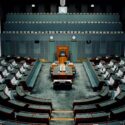The Iowa governor’s office exhibits the work of female artists.
Successful women are often noted as trailblazers in every field. Art has been kept away from women for centuries, partly because women were not allowed to obtain formal education during the biggest art moments in history. For a long time artforms women specialized in were often considered as craft and did not receive any recognition. In addition to that, the works of women like Mary Beale were attributed to her husband that oversaw the studio. Today the women of Iowa have the special opportunity to participate in the Iowa Women’s Art Exhibition. Lee Emma Running took advantage of this opportunity and has her artwork currently exhibited in the governor’s office. She is the first artist to curate a site-specific piece. Her artwork was created with the structure of the governor’s office in mind. Running uses the the large window as her canvas. Running has installed an adhesive vinyl-on-glass piece that depicts the Western Prairie Fringed Orchid, a federally protected species of orchid.
Running views this exhibition as an opportunity to instigate
“It’s been a really wonderful window for me to have pretty serious, engaged conversations with people about big issues of land use
,conservation
and
wildlife.”
Lee Emma Running
A diverse array of women can participate in the exhibition. The works displayed have varied. Artworks on different mediums and of different themes have been exhibited over the course of this initiative. Currently, an installation art piece is in place. Previously there were sculptures and a print that were central to the exhibit.
Running is not the first artist to highlight a social or political issue in need of public discussion. Louise Kames, whose artwork was shown in 2018 in the Iowa Women’s Art Exhibition, portrayed three politically active women who were injured or killed because of their political positions: Malala Yousafzai, a Pakistani activist for female education; Jo Cox, a British Labour Party Member of Parliament; and Gabby Giffords, the U.S. representative of Arizona’s 8th District. All three women were attacked because of the causes that they represented and their public stance.
Kames says then-Lt. Gov. Kim Reynolds conceived the idea for the Iowa Women’s Art Exhibition in 2014 when she noticed all the art in the Capitol was either created by, or depicted, white men.
“So, to have some alternative imagery or expression of the arts with this exhibit is really impactful,” Kames says. She emphasizes the importance of art having a public voice. Artwork is often inspired by events that evoke emotions. As a woman, Kames found that her voice was not heard as much as it should have been, but opportunities like this exhibit are gearing this generation of artists toward a change. An increasing variety of voices are speaking out, which leads to multiple perspectives being seen and heard.
Issues about the environment and the treatment of women in power are not specific to Iowa. But Reynolds, who went on to become Iowa’s first female governor, has paved the path for women in Iowa, and her efforts highlight the importance to create opportunities for different voices to be heard.
Hilde DeBruyne, originally from Belgium but now a resident of Iowa, stands out. The sculptor displayed her bronze sculptures over the second half of last year. The languid and fluid movements of birds have often inspired the shapes and forms in her works.
DeBruyne also mentioned that she was careful to select pieces that represented the female body. The two pieces that she displayed were called “Mindfulness” and “Hope.” DeBruyne’s works are abstract bronze sculptures that symbolize the things she observes in the world. The piece “Hope” is about the size of a grapefruit with a textured bottom half and smooth shiny features on top. This piece was inspired by a friend’s battle with breast cancer and the tenacity displayed by the woman.
These artists have employed their position to bring forth discourse on certain issues. As women it is evident that they felt the need to present the world with the strength that many women embody.
As creators Running, DeBruyne and Kames exhibit a sense of responsibility. Running certainly focuses on the importance of using her voice to initiate change. She thinks it is important to analyze what an artwork truly represents. As a responsible maker Running emphasizes the importance of the process of creation, from the choice of the material to the presentation of said artwork. Art can express things that words cannot, and thus there is a higher responsibility for artists to be explicit with their message.
“The biggest job of art is to observe,”
LEE EMMA RUNNING
Image credits: Iowa Arts Council

